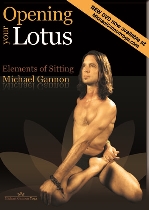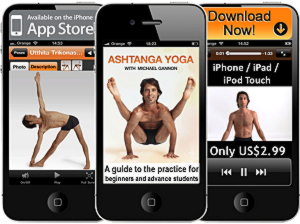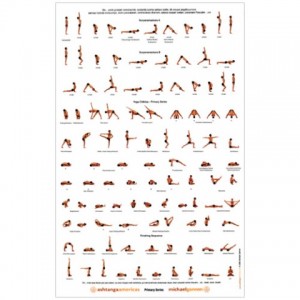Blog | Jul 16, 2016
Gannon Ashtanga Vinyasa Yoga Teacher Training Stories #08
Key Components of Ashtanga Vinyasa Yoga: Breath, Bandhas, Dristi and Vinyasa.
Breath: The most important part of the Ashtanga practice is the breath that drives the purification and the cleansing. Is it the breath that should be our dharana or focus point thourhgout the practice.
In Ashtanga, we use Ujjiayi Breath. Ujjiayi means “victorious”. We seal the lips and breathe in and out through the nose only. We activate this ujjayi breath by narrowing the passageway above the throat and behind the sinuses. The ujjiayi valve helps to control the breath and slow the breath, especially when we move into challenging asanas where the breath may tend to become erratic.
Bandhas: Troughout the practice we mantain control of 2 energetic seals or Bandhas in the body.
Moola Bandha: Moola means “root” and Moola Bandha is located at the base of the spine. Guruji (Sri. K. Pattabhi Jois) says we activate Moola Bandha by sqeezing the anus. This should be subtle. With practice you will be able to squeeze the anus and slowly relax the sphincter muscle, while still feeling the upward lifting energy.
Moola Bandha helps to prevent the life force (prana) from escaping out the bottom of the body.
Uddiyana Bandha: Uddiyana means “to fly up”, and Uddiyana Banda is located just below the navel. We activate Uddiyana Bandha by drawing the lower abdomen inward, toward the spine, and upward. We never do belly breathing in Ashtanga, and the Uddiyana helps us to draw the life force upward, flooding the heart and lungs with prana. Uddiyana also protects the vital organs and helps to create space for forward bends and twists.
Michael Gannon explains the 4 key components
of the Ashtanga Vinyasa Yoga practice
It is the combination of Breath & Bandhas that creates the magic of Ashtanga. Strong intention in our breath and continuous awareness of our bandhas allows us to activate our core strength.
We then discover this ligtness that allows us to defy gravity and float through the practice.
Dristis are gazing points that we use to keep us focused in the practice. There are 9 dristis in Ashtanga, and each assana and vinyasa has a prescribed dristi. The 3rd eye (Broomadhya), the tip of the nose (Nasagrai), the navel (Nabi Chakra), the hand (Hastagrai), the toes (Padayoragrai), the thumbs (Angusta Ma Dai), up to the sky (Urdva), and to the side (Parsva), both left and right.
Vinyasa
Vinyasa is one of the most distinguishing characteristics of the Ashtanga System. Vinyasa means “breath and movement”. Each movement we make in the ashtanga practice is coordinated with a specific breath, inhale or exhale. This prescribed breathing system should never change.
Componentes clave de Ashtanga Vinyasa Yoga: la Respiración, Bandhas, Dristi y Vinyasa.
Respiración: La parte más importante de la práctica de Ashtanga es el aliento que impulsa la purificación y la limpieza. ¿Es la respiración que debe ser nuestra dharana o punto de enfoque a lo largo de la práctica.
En Ashtanga, utilizamos la respiracion Ujjiayi . Ujjiayi significa “victorioso”. Sellamos los labios y respiramos dentro y fuera sólo a través de la nariz. Activamos este aliento ujjayi por el estrechamiento del conducto por encima de la garganta y detrás de los senos paranasales. La válvula ujjiayi ayuda a controlar el respiro y disminuir la respiración, especialmente cuando nos movemos en asanas difíciles donde la respiración puede tender a ser errática.
Bandhas: atraves de la práctica mantenemos el control de 2 candados energeticos o Bandhas en el cuerpo.
Moola Bandha, moola significa “raíz” y Moola Bandha se encuentra en la base de la columna vertebral. Guruji (Sri. K. Pattabhi Jois) dice activamos Moola Bandha apretando el ano. Esto debe ser sutil. Con la práctica usted será capaz de apretar el ano y lentamente relajar el músculo del esfínter, mientras que todavía se siente la energía de elevación hacia arriba.
Moola Bandha ayuda a evitar que la fuerza vital (prana) se escape por la parte inferior del cuerpo.
Uddiyana Bandha, uddiyana significa “volar hacia arriba“, y Uddiyana Banda se encuentra justo debajo del ombligo. Activamos Uddiyana Bandha dibujando la parte inferior del abdomen hacia adentro, hacia la columna vertebral, y hacia arriba. Nunca hacemos la respiración abdominal en Ashtanga, y el Uddiyana nos ayuda a tomar la fuerza vital hacia arriba, inundando el corazón y los pulmones con el prana. Uddiyana también protege los órganos vitales y ayuda a crear un espacio para flexiones hacia adelante y giros.
Es la combinación de respiración y Bandhas que crea la magia de Ashtanga. Fuerte intención de la respiración y la conciencia continua de nuestros bandhas nos permite activar nuestra fuerza central.
Descubrimos entonces este ligereza que nos permite desafiar la gravedad y flotar en la práctica.
Dristi son puntos que utilizamos para mantenernos enfocada nuestra miradas en la práctica. Hay 9 dristis en Ashtanga, y cada Asana y vinyasa tiene un dristi prescrito. El 3er ojo (Broomadhya), la punta de la nariz (Nasagrai), el ombligo (Nabi chakra), la mano (Hastagrai), los dedos de los pies (Padayoragrai), los pulgares (Angusta Ma Dai), hasta el cielo (Urdva) , y al lado (Parsva), tanto a la izquierda ya la derecha.
Vinyasa
Vinyasa es una de las características más distintivas del sistema de Ashtanga. Vinyasa significa “respiración y el movimiento“. Cada movimiento que hacemos en la práctica de ashtanga se coordina con una respiración inhalar-exhalar o específica. este sistema respiratorio prescrito nunca debe cambiar.









